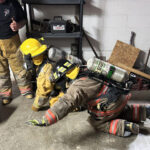Crown of Maine sportsmen know one thing for certain about the weather, if you don’t like it just hang on a day or two and it’s likely to change drastically. A couple of weeks ago following several days of heavy rain, regional rivers, brooks, and even many ponds became muddy and inflated well beyond spring freshet levels, Fishing prospects became dismal.
Currently, after several days of shimmering sun and temperatures in the high ‘80s, normal summer fishing conditions are at hand. Brook trout in rivers school up near ledge seeps, spring holes, and small creek inlets, as well as in deep holes. All spots where cold water offers comfort and increased oxygen. Brooks connected to larger waterways benefit as large numbers of fish migrate from the warming, oxygen-depleted stream to the cooler, brush-shrouded sanctuaries.
Anglers near the Aroostook River, Meduxnekeag River, Little Madawaska, Machias or Prestile need to narrow their casting forays to certain holding pools. For consistent action plan to fish just at daybreak for an hour or so and between dusk and full darkness. I prefer to stand near a brook inlet or near a ledge or undercut bank and wait for fish to rise for a hatch, a pretty dependable occurrence this time of year early and late in the day.
Using a 7-1/2 to 9-foot leader with a three or four pound tippet and one of the several sure-fire dry fly patterns in size 14, 16, or 18, a few strikes are likely. Schooled-up fish are particularly skittish and will quickly develop lockjaw after several are hooked and played from the group. A couple of tricks to extend the action include placing casts from the outside edge of the school and working inward, changing fly size, shape and color after catching half a dozen fish, and giving the school a rest for 10- to 15-minutes after catching a few trout.
Since many of the larger waterways I’ve mentioned have dozens of inletting creeks, plan on hopscotching between two or three for consistent action. Dry fly patterns sure to elicit strikes on any local river include a Henryville special, mosquito, gray slim Jim, light Cahill, olive blue dun and a Hendrickson.
In spite of the many brook inlets on larger waterways, most get steady pressure, so I often turn to the smaller brooks for reduced competition and more dependable action on a fly. Since there are hundreds of brooks and creeks, most local fishermen will live within 15 or 20 minutes of one. For a bit of solitude and waterways with lighter angling pressure, a half hour drive or so puts most sportsmen on the bank of a big woods brook.
Urban edge streams tend to flow alternately through farm land and forested areas while deep woods brooks are heavily lined with trees and dense foliage. Because of the tree and brush foliage that often almost forms a canopy over the water, trout get some protection from the sun and avian predators. Also the water stays cooler on the warmest of days and fish remain more responsive to baits. Tossing out a worm and silver spinner draws strikes on most streams even during the brightest part of the day, but fly fishing may require a bit more finesse.
Many of the brooks are narrow and confined by foliage so a shorter rod, 6 1/2 to 7 feet, shorter leaders and precision casting are beneficial. During July and August trout tend to congregate in small pools, some the size of a bathtub, others the size of an automobile. Bank undercuts, corner eddies and long sets of medium-depth riffles constitute dependable casting sites.
Anglers between Monticello and Houlton should visit the North and South branches of the Meduxnekeag, B stream, and Big Brook. Three Brooks, Whitney Brook and Rocky Brook near Mars Hill and Bridgewater are perennial warm weather trout producers. Hockenhull in Fort Fairfield, Little Madawaska in Caribou and New Sweden, and Gardiner Brook in Washburn comprise several other regional favorites for late summer trout.
Wet flies often work on these small waterways, especially colorful patterns, and even during mid-day these bright patterns work well. Try a Parmachene belle, silver doctor, trout Finn, or a professor. Dry flies other than the ones I’ve previously mentioned that merit a try include a Royal Coachman, gold ribbed hare’s ear and a blonde Wulff. My very favorite late summer fly, fished dry or partially wet, is a yellow-bodied grasshopper. Orange and green bodies also work, but whatever the color, have a few ’hoppers on hand.
Local brooks are receding and trout are schooling up, so it’s time to enjoy some fast and furious surface action. Fooling a crafty brookie into striking a fake, floating fur and feather imitation provides one of the most satisfying fishing accomplishments. Get out now before more rain arrives.
Presque Isle, ME
70
Clouds
Houlton, ME
66
Clear
Caribou, ME
69
Clouds
Fort Kent, ME
69
Clouds
Change Location
- Presque Isle
- Houlton
- Caribou
- Fort Kent
© 2024 Bangor Publishing Company.







